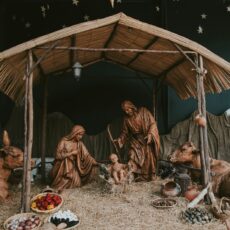
Introduction to the Celebration of Christmas
Christmas, a widely celebrated holiday occurring annually on December 25th, holds significant importance across various cultures and societies around the globe. The day commemorates the birth of Jesus Christ, a foundational figure in Christianity, representing themes of hope, joy, and renewal. While the holiday’s religious roots are evident, Christmas has evolved into a broader cultural phenomenon embraced by individuals from diverse backgrounds, transcending merely theological observations.
The selection of December 25th as Christmas Day is historically intriguing. Although the exact date of Jesus’ birth is not noted in biblical texts, early Christian leaders designated this date as a symbolic nod to pagan festivals also observed during this time. The winter solstice, which occurs around December 21st or 22nd, marked a new cycle of sunlight, renewal, and rebirth in many ancient cultures. By aligning the celebration of Christ’s birth with these existing festivals, early Christians sought to facilitate a smoother integration of Christian beliefs within a predominantly pagan society.
Additionally, various traditions surrounding Christmas can be traced back to ancient customs. For example, the incorporation of evergreen trees, wreaths, and lights into Christmas celebrations symbolizes everlasting life and hope during the winter months. As the holiday gained popularity throughout the centuries, myriad customs, ranging from gift-giving to festive meals, emerged, reflecting the diverse cultural influences that shape contemporary celebrations of Christmas.
In essence, the significance of December 25th goes beyond its religious connotations, embodying a rich tapestry of historical and cultural influences. This multifaceted holiday continues to resonate with people worldwide, promoting messages of unity and goodwill as it draws families and communities together in celebration.
Historical Context of December 25th
The celebration of Christmas on December 25th has deep historical roots, intertwining various cultural and religious practices. One of the key influences on this date is the ancient Roman festival of Saturnalia, which occurred in mid-December. This week-long celebration honored Saturn, the god of agriculture, and involved feasting, gift-giving, and merriment. The joyful atmosphere and communal spirit of Saturnalia paved the way for a transformative adaptation by early Christians.
Additionally, the Winter Solstice, typically occurring around December 21st or 22nd, marked the shortest day of the year and the gradual return of longer daylight hours. Many ancient cultures, including the Romans, celebrated this revival of light through various rituals and festivals. These pagan festivities, emphasizing renewal and rebirth, resonated deeply within the context of Christian theology. Early church leaders recognized the potential to align these existing celebrations with the Christian narrative of the birth of Jesus Christ, symbolizing light entering the world.
The choice of December 25th as the date for Christmas appears to have been influenced by the desire to replace pagan festivities with a Christian holiday. By doing so, early Christians aimed to convert pagans to Christianity by integrating familiar customs into the new faith. The first recorded mention of December 25th as the date of Jesus’ birth came from the Roman calendar in the mid-4th century, during a time when Christianity was gaining prominence and seeking to establish a distinct identity.
In essence, the historical context of December 25th is rich and complex, representing a convergence of pagan traditions and early Christian beliefs. This synthesis not only helped to facilitate the acceptance of Christianity but also established a unique cultural holiday that continues to be celebrated worldwide today.
Biblical References and Theological Significance
The celebration of Christmas on December 25th is deeply rooted in theological significance, despite the absence of a specific date for Jesus Christ’s birth in the Bible. Early Christians, seeking to commemorate the Nativity, turned to various biblical texts and traditions to justify the choice of this date. One pivotal verse often cited is from the Gospel of Luke (2:10-14), where the angel announces to the shepherds the birth of the Savior, announcing joy and peace on earth. This proclamation underscores the theological importance of Jesus’s birth, positioning it as a transformative event in salvation history.
While the Bible does not specify a date for Jesus’s birth, several early ecclesiastical writers, such as Hippolytus of Rome, proposed December 25th based on calculations that aligned with the Feast of the Annunciation (celebrated nine months earlier). The theological reasoning behind selecting this date may also have been influenced by the desire to coincide with existing pagan festivals such as the Roman Saturnalia. This strategic alignment allowed early Christians to offer a compelling narrative of light conquering darkness, symbolically represented by the birth of Christ during the winter solstice when days begin to grow longer.
Cultural Adaptations and Regional Variations
The celebration of Christmas on December 25th manifests a diverse array of customs and traditions influenced by regional cultures around the globe. While the core significance of the holiday remains linked to the birth of Jesus Christ, how this event is commemorated varies greatly from one culture to another. In many Western countries, such as the United States and those in Western Europe, Christmas is celebrated with a strong emphasis on family gatherings, gift-giving, and elaborate meals. These practices have become a hallmark of festive spirit alongside the well-known figure of Santa Claus, who has become a central character in popular Christmas lore.
In countries like Mexico, the Christmas season extends beyond December 25th, marked by vibrant festivities such as Las Posadas. This tradition involves reenacting Mary and Joseph’s search for lodging, culminating in communal celebrations filled with music, food, and piñatas. In contrast, in Ethiopia, Christmas is celebrated on January 7, according to the Julian calendar, with a focus on religious observance rather than commercial activities. This highlights a significant regional variation that stems from differing historical and theological contexts.
Moreover, in many parts of Europe, local customs have adapted Christmas celebrations to reflect distinct cultural narratives. For example, in Italy, families celebrate the Feast of the Seven Fishes on Christmas Eve, emphasizing traditional culinary practices. Similarly, in Eastern European countries, Christmas traditions may include attending midnight church services and enjoying specific foods that symbolize new beginnings and the richness of life.
As globalization spreads, many of these practices are blended, creating unique hybrid traditions in various regions. Cultural adaptations of Christmas reveal not only the religious significance of the day but also the intricate tapestry of human experience throughout history. This diverse celebration underscores the universal themes of joy, togetherness, and the spirit of giving that resonate with many, regardless of how the day is commemorated.
Modern-Day Christmas Traditions
The celebration of Christmas on December 25th has evolved significantly over the years, resulting in a variety of traditions that have become ingrained in contemporary society. Gift-giving is one of the most notable customs associated with this holiday. Originally, this practice harkens back to the Magi presenting gifts to the newborn Jesus; however, in modern times, it has transformed into an extensive commercial phenomenon. Retailers capitalize on the festive spirit, driving consumer spending and encouraging individuals to exchange presents with family and friends, thereby enhancing social bonds and fostering goodwill.
Another prominent aspect of modern Christmas traditions is the decoration of homes and public spaces. The use of Christmas trees, adorned with lights and ornaments, has become a central feature of the holiday season. This custom is believed to have originated in Germany in the 16th century, but its popularity has proliferated across the globe. The display of decorative lights, wreaths, and nativity scenes has also become common, creating a festive atmosphere that signifies the joy of the season. Many communities engage in holiday lighting contests, aiming to showcase their creativity and contribute to the communal celebration of Christmas.
Furthermore, festive meals serve as an essential component of Christmas celebrations. The gathering of family members and friends to enjoy a special meal is a time-honored tradition that varies by culture and region. While turkey and ham are popular choices in many Western countries, others may prefer traditional dishes that reflect their heritage. The act of sharing food during this holiday symbolizes unity and love, reinforcing the importance of togetherness during a time of reflection and celebration.
Ultimately, these modern-day Christmas traditions have been shaped by a combination of historical practices and contemporary influences, such as commercialism and cultural exchange. They not only celebrate the holiday’s origins but also provide an avenue for individuals and families to create lasting memories during the festive season.
Impact of Christmas Commercialization
Christmas celebrated on December 25th, has evolved into a day that is heavily influenced by commercialization and consumerism. As the holiday season approaches, businesses ramp up marketing efforts, leading to a proliferation of advertisements promoting gifts, decorations, and festive experiences. This commercialization has significantly altered the way individuals, families, and communities engage with the holiday, often overshadowing its traditional meaning. The focus has shifted from spirituality and family bonding to a consumer-oriented frenzy, where the values of generosity and togetherness can sometimes be lost amidst the pursuit of material goods.
The origins of Christmas are deeply rooted in religious traditions, commemorating the birth of Jesus Christ. However, as society has become increasingly consumer-driven, elements of this sacred celebration have been commodified. Retailers exploit this time of year, positioning their products and services as essential for a “perfect” Christmas experience. This marketing strategy exacerbates the pressure on individuals to purchase gifts, which may lead to feelings of inadequacy or stress during what is intended to be a joyful season.
Despite the overwhelming presence of commercial elements during Christmas, there exists an important dialogue about the significance of re-establishing a connection to the holiday’s core values. Many advocate a return to simpler celebrations that prioritize meaningful interactions, such as spending quality time with loved ones, engaging in charitable acts, and reflecting on personal values. Individuals must strike a balance between honoring tradition and navigating the complexities of modern commercialization. By increasing awareness around the implications of consumerism on Christmas, we can shape a more intentional celebration that honors both the historical and the contemporary aspects of this important day.
Controversies Surrounding December 25th
The adoption of December 25th as the date for Christmas has sparked various debates and controversies throughout history. Scholars and theologians have posited different arguments regarding the validity of this date, leading to an array of interpretations within both religious and historical contexts. One prevalent theory suggests that the selection of December 25th was influenced by pre-existing pagan celebrations, notably the Roman festival called Saturnalia, which celebrated the winter solstice. This festival was characterized by feasting, gift-giving, and revelry, leading some to argue that early Christians appropriated the date to facilitate the acceptance of Christianity among pagan populations.
Furthermore, certain scholars advocate for alternative dates for Christ’s birth based on biblical and astronomical evidence. For instance, some propose that Jesus may have been born in the spring or early fall. These theories are often rooted in interpretations of celestial events, such as the Star of Bethlehem, and the timing of shepherds in the fields, as mentioned in the Gospel of Luke. Thus, the historical context gives rise to legitimate skepticism about the traditional December 25th date.
Additionally, the emergence of various sects within Christianity has led to differing views on the significance of this date. Some groups, such as the Jehovah’s Witnesses, reject the celebration of Christmas altogether, citing its potential pagan roots and a lack of explicit biblical endorsement. Others, while accepting December 25th, emphasize the need for a more profound religious observance detached from commercialism. Such opposing viewpoints contribute to ongoing discussions about the meaning and significance of Christmas, highlighting that the date’s implications extend beyond mere calendrical convenience. Through this discourse, December 25th remains a focal point of controversy, prompting deeper exploration into the foundations of one of Christianity’s most celebrated events.
The Global Impact of the Christmas Celebration
The celebration of Christmas on December 25th holds significant global importance, transcending its origins to become a pivotal event in various cultures around the world. Historically rooted in Christian traditions, this holiday has expanded its influence to include secular aspects, thereby fostering a sense of unity and community among people of diverse backgrounds. In many countries, Christmas symbolizes more than the commemoration of the birth of Jesus Christ; it has evolved into a collective celebration of togetherness, goodwill, and shared values.
Through various customs such as gift-giving, festive meals, and communal gatherings, Christmas encourages interactions among family, friends, and community members. These interactions often promote social cohesion, highlighting the importance of charity and kindness, which are central themes during the holiday season. In addition, many regions incorporate local traditions, which enrich the Christmas experience and allow for a celebration that resonates on both personal and collective levels. This blend of customs showcases the uniqueness of individual cultures while still upholding a globally recognized celebration.
However, the global proliferation of Christmas has also brought about challenges, especially in the context of globalization. The commercialization of the holiday has led to a shift in its meaning for some, where the focus on consumerism often overshadows the original intentions of joy and community spirit. Furthermore, as Christmas becomes more widespread, there is a risk of cultural homogenization, potentially sidelining local customs and traditions in favor of a more uniform celebration. This paradox presents an ongoing dialogue about maintaining cultural identity while embracing communal celebrations globally.
Conclusion: Reflecting on the Meaning of Christmas
Christmas celebrated on December 25th, holds a profound significance for millions around the world. This day serves not only as a religious observance commemorating the birth of Jesus Christ but also as a time steeped in rich traditions and cultural practices. Through the lens of history, we observe how Christmas has evolved, embracing various customs and rituals that enhance its meaning. The historical context provides insight into how communities over centuries have adapted to maintain the essence of this celebration, which intertwines spirituality with social connection.
The social aspect of Christmas cannot be overlooked. It has become a symbol of togetherness, where families gather to share meals, exchange gifts, and partake in festive activities. This communal spirit fosters a sense of belonging and reinforces connections among individuals. The traditions associated with Christmas, such as decorating trees, singing carols, and attending church services, contribute to the overall warmth of the season, making it a cherished time for many. The act of giving also plays a central role, reflecting themes of generosity, kindness, and compassion that resonate deeply within the human experience.
Moreover, the personal significance of December 25th varies from individual to individual. For some, it is a day of profound religious reflection, while for others, it signifies a time for family bonding and celebration of community. Regardless of one’s specific beliefs or practices, the essence of Christmas encourages an introspective look at personal values, aspirations, and relationships. It invites individuals to cultivate a spirit of goodwill, thereby promoting peace within oneself and among others.
Ultimately, as we reflect on the meaning of Christmas, it becomes clear that this day offers an opportunity to unite in love and hope, bridging divides and nurturing the human spirit. Each December 25th presents a chance to honor traditions while fostering new connections, making it a date worthy of celebration for all.
















A well-placed “Moving on…” can save a joke — comedywriter.info
The more specific, the funnier—avoid vagueness — comedywriter.info
Comedy is about tension and release — comedywriter.info
A well-timed sigh can be a punchline — comedywriter.info